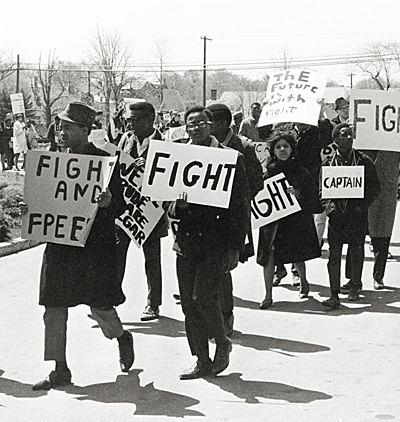In Review
 HISTORY MAKERS: The struggle for civil rights in Rochester during the 1960s and 1970s launched strategies to protest employment discrimination that became models for other parts of the country, a period that is being documented in a new online resource at University libraries. (Photo: Kodak Historical Collection/Department of Rare Books, Special Collections, and Preservation)
HISTORY MAKERS: The struggle for civil rights in Rochester during the 1960s and 1970s launched strategies to protest employment discrimination that became models for other parts of the country, a period that is being documented in a new online resource at University libraries. (Photo: Kodak Historical Collection/Department of Rare Books, Special Collections, and Preservation)When Walter Cooper ’57 (PhD) came to Rochester as a graduate student in 1952, he lived on the University campus. But when he married in 1953, he remembers, “being married, I then confronted the housing segregation in Rochester.”
Cooper and his wife, Helen, answered ads for 69 Rochester apartments. They were refused at all of them.
Cooper, who went on to become the first African American to earn a doctorate in physical chemistry from the University and then a research scientist at Eastman Kodak, was a founding member of the Rochester chapter of the Urban League and of Action for a Better Community.
Cooper is one of several activists and community members who have shared their recollections of their lives in Rochester—the discrimination they faced, and the actions they took—as part of a new online project by the Department of Rare Books and Special Collections that aims to capture a tumultuous era in Rochester history.
As part of the Rochester Black Freedom Struggle Online History Project, the library has recorded and is making available online interviews with more than 20 key players from Rochester’s fight against racial discrimination during the 1960s and 1970s.
“Rochester’s African-American history extends far beyond the life of Frederick Douglass,” says Richard Peek, the director of Rare Books and Special Collections. “The collection materials acquired and preserved during this project, along with the developing Web site, will contribute to the ongoing community effort to help bring this history to light.”
When completed, the project’s Web site will offer text, audio, and video files of the conversations. In the interviews, civil rights activists relive the emotions and events surrounding the turbulent years and provide a rich perspective on the city’s response to one of its darkest hours.
A turning point in that history was the outbreak of race riots in the city of Rochester in 1964. The three nights of rioting left four people dead, 350 injured, and more than 800 arrested. But those disturbing July days also broke through the community’s complacency toward racial discrimination that had fomented such civil unrest. In the aftermath of the riots, Rochester became the birthplace of several civil rights strategies that would later serve as models across the nation.
“Actually hearing the interviews is more powerful than anything I could describe,” says Phyllis Andrews, a librarian who led the project over the past year. “For today’s student, 1964 can seem like ancient history. This oral history project will help to bring those events to life and create a permanent resource for continued study and learning.”
Visitors to the site will be able to read and listen to the stories of community activists Constance Mitchell and Loma Allen, businessmen Horace Becker and Clarence Ingram, and ministers Raymond Scott, Herb White, and Robert Kreckel. Charles Price, the first African-American police officer in Rochester, describes his arrest by state police during a riot patrol as a plainclothes officer. Darryl Porter, now an assistant to Rochester Mayor Robert Duffy, recalls his leadership of a local youth gang, the Matadors.
“These are people who gave so much of their lives to the community. It is an amazing thing to hear people tell their stories. It completely changes what I thought I knew,” says Laura Warren Hill, a doctoral student at Binghamton University who conducted the interviews for the project. Her dissertation, “Strike the Hammer While the Iron Is Hot: The Black Freedom Struggle in Rochester, NY, 1945–1975,” examines the Rochester riots, their origins, and aftermath.
“The narrative of black struggle is that the civil rights movement was in the South, then the focus moves to the Black Power movement in California. Rochester is not on the map,” says Hill.
But Rochester activists pioneered some important strategies. Rochester’s civil rights group FIGHT, for example—which was formed in response to the riots—experimented effectively with a proxy strategy. By asking individuals and churches for voting rights to their Kodak shares, the group was able to attend shareholders’ meetings and challenge the corporation’s hiring practices. The confrontation, covered in the Wall Street Journal and other national media, eventually pushed Kodak to hire 600 minority workers and implement further job training programs.
“What happened in Rochester has the potential to rewrite what scholars know about civil rights,” Hill says.
Librarians hope that interest in the site will help them identify more candidates for interviews. The project has already assisted the library in obtaining important additions to its collections related to the riots and the city’s recovery, including Cooper’s papers. The Web site features links related to 19th- and 20th-century library collections, including the Frederick Douglass Papers, the Susan B. Anthony Papers, the Rochester Race Riot Papers, the Franklin Florence Papers, and the Rocky Simmons Photographs.
Visit the Web site.
Susan Hagen writes about the social sciences for University Communications.
